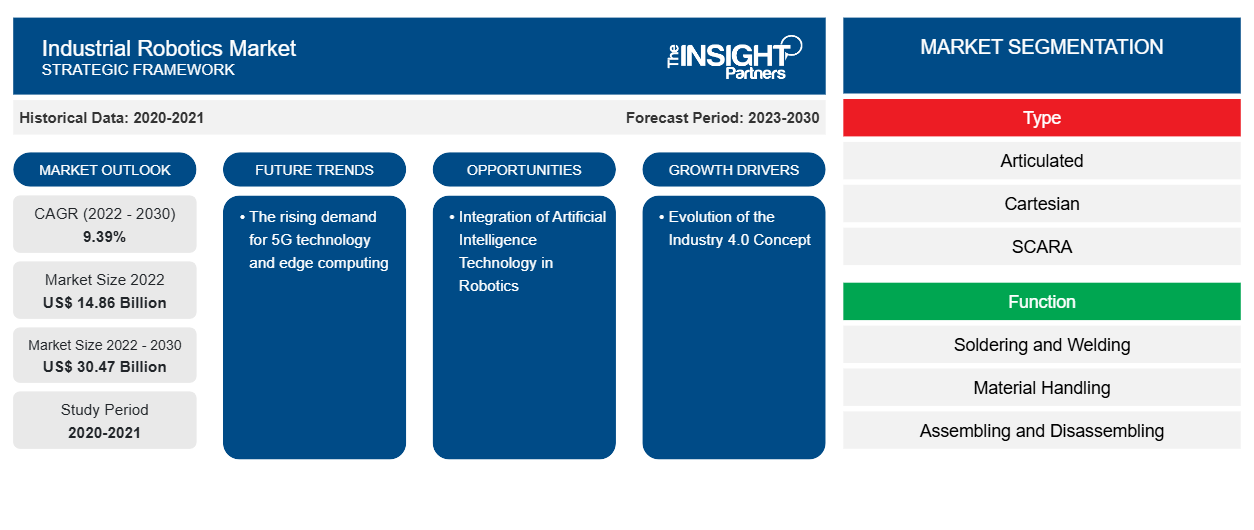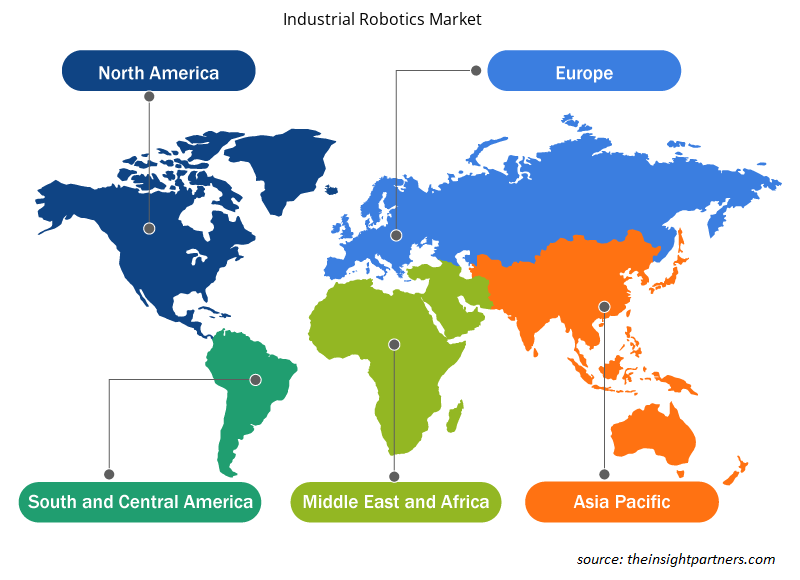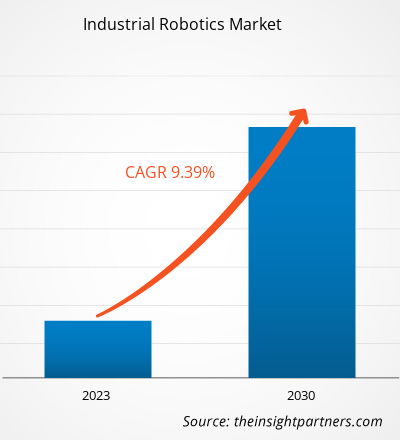The industrial robotics market size is projected to reach US$ 30.47 billion by 2030 from US$ 14.86 billion in 2022. The market is expected to register a CAGR of 9.39% during 2022–2030. The rising demand for 5G technology and edge computing is likely to remain a key trends in the market.
Industrial Robotics Market Analysis
The evolution of the Industry 4.0 Concept and the growing demand for collaborative robots for enhancing operational efficiency are driving the market. The market is anticipated to grow during the forecast period due to the growing demand for automation in the manufacturing, warehouse, and logistics industries. Moreover, the integration of artificial intelligence technology in robotics is creating lucrative opportunities for the market.
Industrial Robotics Market Overview
Industrial robotics can be defined as robotic arms equipped with sensors and controls that can execute a variety of functions and operations in the creation of industrial products. They are programmed to perform repetitive tasks in cycles. These robots drastically reduce the human elements involved in production while also increasing processing speed, quality, and production capacity. The most significant component of the robot is undoubtedly the arm, which is made up of joints and connections. The end-of-the-arm tool (EOAT) is the most critical component of the robotic arm. They undertake a variety of tasks, including marking, cutting, welding, drilling, painting, and cleaning.
Customize This Report To Suit Your Requirement
You will get customization on any report - free of charge - including parts of this report, or country-level analysis, Excel Data pack, as well as avail great offers and discounts for start-ups & universities
Industrial Robotics Market: Strategic Insights

- Get Top Key Market Trends of this report.This FREE sample will include data analysis, ranging from market trends to estimates and forecasts.
You will get customization on any report - free of charge - including parts of this report, or country-level analysis, Excel Data pack, as well as avail great offers and discounts for start-ups & universities
Industrial Robotics Market: Strategic Insights

- Get Top Key Market Trends of this report.This FREE sample will include data analysis, ranging from market trends to estimates and forecasts.
Industrial Robotics Market Drivers and Opportunities
Evolution of the Industry 4.0 Concept to Favor the Market
Industry 4.0 represents the ongoing transformation of the manufacturing and industrial landscape, characterized by the convergence of advanced technologies such as robotics, automation, artificial intelligence (AI), and the Internet of Things (IoT). This fourth industrial revolution marks a shift from traditional automation to intelligent, interconnected systems that enable data-driven decision-making and real-time process optimization. One of the most significant developments under the Industry 4.0 framework is the integration of industrial IoT (IIoT) and AI into robotic systems. These technologies are enabling the emergence of autonomous and collaborative robots (cobots) capable of operating independently, interacting safely with human workers, and adapting to dynamic production environments. Unlike earlier generations of robots, which were limited to fixed, repetitive tasks, modern robotic systems are highly flexible and responsive to changes in operational conditions.The Industry 4.0 powers innovative maintenance strategies, particularly predictive and condition-based maintenance, which rely on real-time data analytics and machine learning. These approaches minimize unplanned downtime, optimize asset utilization, and reduce maintenance costs—delivering substantial operational efficiencies. These advancements are expected to accelerate the adoption of robotics across various industries, including automotive, electronics, logistics, and pharmaceuticals. The ability to automate previously manual, labor-intensive tasks not only enhances productivity but also addresses growing challenges such as labor shortages and rising wage pressures.
Further, the deployment of smart robotic systems is enhancing machine management and production visibility, allowing businesses to respond more swiftly to demand fluctuations and production anomalies. As manufacturers continue to invest in digital transformation, the demand for intelligent robotic solutions is anticipated to grow significantly over the coming years. By harnessing the power of connectivity, AI, and automation, businesses are poised to achieve greater agility, efficiency, and competitiveness in an increasingly digital economy. Thus, the evolution of Industry 4.0 is redefining the role of robotics in industrial environments, in turn, bolstering the industrial robotics market
Integration of Artificial Intelligence Technology in Robotics
AI is driving remarkable progress in the robotics and automation sector. As AI in robotics evolves and blooms, numerous industries are capitalizing on these cutting-edge technologies, such as implementing intelligently automated processes to fuel sophisticated data collection and analysis, allowing businesses, services, and manufacturers to make data-driven decisions, or implementing self-learning robots to facilitate work processes and tasks. The adoption of AI-based self-learning robots is expected to create opportunities in the market during the forecast period.Industrial Robotics Market Report Segmentation Analysis
Key segments that contributed to the derivation of the industrial robotics market analysis are type, function, and industry.- Based on type, the industrial robotics market is divided into articulated, cartesian, SCARA, collaborative, parallel, and others. The articulated segment held the largest market share in 2022.
- By function, the market is segmented into soldering and welding, material handling, assembling and disassembling, painting and dispensing, milling, and cutting and processing. The material handling segment held the largest market share in 2022.
- In terms of industry, the market is divided into automotive, medical & pharmaceuticals, electrical & electronics, rubber & plastics, metal & machinery, and food & agriculture. The food & agriculture segment held the largest market share in 2022.
Industrial Robotics Market Share Analysis by Geography
The geographic scope of the industrial robotics market report is mainly divided into five regions: North America, Asia Pacific, Europe, Middle East & Africa, and South & Central America.The market in Europe is projected to expand during the forecast period due to the increasing demand for industrial robots. Industrial robot installations climbed 33% in 2021 compared to 2020. In 2021, industrial robot usage increased by 22% in the electronics industry, 57% in the automotive industry, and 29% in the metal and machinery business, compared to 2020. According to IFR, in January 2023, China, Japan, and South Korea were among the top five most advanced countries in terms of yearly industrial robot installations, with China's industrial robotics market experiencing the highest development.
Industrial Robotics Market Regional Insights
The regional trends and factors influencing the Industrial Robotics Market throughout the forecast period have been thoroughly explained by the analysts at The Insight Partners. This section also discusses Industrial Robotics Market segments and geography across North America, Europe, Asia Pacific, Middle East and Africa, and South and Central America.

- Get the Regional Specific Data for Industrial Robotics Market
Industrial Robotics Market Report Scope
| Report Attribute | Details |
|---|---|
| Market size in 2022 | US$ 14.86 Billion |
| Market Size by 2030 | US$ 30.47 Billion |
| Global CAGR (2022 - 2030) | 9.39% |
| Historical Data | 2020-2021 |
| Forecast period | 2023-2030 |
| Segments Covered |
By Type
|
| Regions and Countries Covered | North America
|
| Market leaders and key company profiles |
Industrial Robotics Market Players Density: Understanding Its Impact on Business Dynamics
The Industrial Robotics Market is growing rapidly, driven by increasing end-user demand due to factors such as evolving consumer preferences, technological advancements, and greater awareness of the product's benefits. As demand rises, businesses are expanding their offerings, innovating to meet consumer needs, and capitalizing on emerging trends, which further fuels market growth.
Market players density refers to the distribution of firms or companies operating within a particular market or industry. It indicates how many competitors (market players) are present in a given market space relative to its size or total market value.
Major Companies operating in the Industrial Robotics Market are:
- Fanuc Corp
- ABB Ltd
- Yaskawa Electric
- KUKA AG
- Universal Robotics AS
- Comau SpA
Disclaimer: The companies listed above are not ranked in any particular order.

- Get the Industrial Robotics Market top key players overview
Industrial Robotics Market News and Recent Developments
The industrial robotics market is evaluated by gathering qualitative and quantitative data post primary and secondary research, which includes important corporate publications, association data, and databases. A few of the developments in the industrial robotics market are listed below:- ABB Ltd reaffirmed its commitment to one of its most important client markets, the US, by beginning construction on expanding its current robotics headquarters and production plant in Auburn Hills, Michigan. The project will be completed by November 2023 and is expected to cost US$ 20 million. The expansion will create 72 new highly skilled jobs in the area, backed by a US$ 450,000 performance-based grant from the Michigan Business Development Program. (Source: ABB Ltd, Company Website, March 2023)
Industrial Robotics Market Report Coverage and Deliverables
The “Industrial Robotics Market Size and Forecast (2020–2030)” report provides a detailed analysis of the market covering below areas:- Industrial robotics market size and forecast at global, regional, and country levels for all the key market segments covered under the scope
- Industrial robotics market trends as well as market dynamics such as drivers, restraints, and key opportunities
- Detailed PEST/Porter’s Five Forces and SWOT analysis
- Industrial robotics market analysis covering key market trends, global and regional framework, major players, regulations, and recent market developments
- Industry landscape and competition analysis covering market concentration, heat map analysis, prominent players, and recent developments for the industrial robotics market
- Detailed company profiles
Frequently Asked Questions
What would be the estimated value of the industrial robotics market by 2030?
The global industrial robotics market is expected to reach US$ 30.47 billion by 2030.
Which are the leading players operating in the industrial robotics market?
The key players holding majority shares in the global industrial robotics market are Fanuc Corp, ABB Ltd, Yaskawa Electric, KUKA AG, Universal Robotics AS, Comau SpA, Mitsubishi Electric Corp, Seiko Epson Corp, Staubli International AG, Kawasaki Heavy Industries Ltd
What are the future trends of the industrial robotics market?
The rising demand for 5G technology and edge computing to play a significant role in the global industrial robotics market in the coming years.
Which region dominated the industrial robotics market in 2022?
Asia Pacific dominated the industrial robotics market in 2022.
What are the driving factors impacting the industrial robotics market?
The evolution of the Industry 4.0 Concept and the growing demand for collaborative robots for enhancing operational efficiency are the major factors that propel the global industrial robotics market.
What is the expected CAGR of the industrial robotics market?
The global industrial robotics market is estimated to register a CAGR of 9.39% during the forecast period 2022–2030.
- Historical Analysis (2 Years), Base Year, Forecast (7 Years) with CAGR
- PEST and SWOT Analysis
- Market Size Value / Volume - Global, Regional, Country
- Industry and Competitive Landscape
- Excel Dataset
Testimonials
Reason to Buy
- Informed Decision-Making
- Understanding Market Dynamics
- Competitive Analysis
- Identifying Emerging Markets
- Customer Insights
- Market Forecasts
- Risk Mitigation
- Boosting Operational Efficiency
- Strategic Planning
- Investment Justification
- Tracking Industry Innovations
- Aligning with Regulatory Trends
Yes! We provide a free sample of the report, which includes Report Scope (Table of Contents), report structure, and selected insights to help you assess the value of the full report. Please click on the "Download Sample" button or contact us to receive your copy.
Absolutely — analyst assistance is part of the package. You can connect with our analyst post-purchase to clarify report insights, methodology or discuss how the findings apply to your business needs.
Once your order is successfully placed, you will receive a confirmation email along with your invoice.
• For published reports: You’ll receive access to the report within 4–6 working hours via a secured email sent to your email.
• For upcoming reports: Your order will be recorded as a pre-booking. Our team will share the estimated release date and keep you informed of any updates. As soon as the report is published, it will be delivered to your registered email.
We offer customization options to align the report with your specific objectives. Whether you need deeper insights into a particular region, industry segment, competitor analysis, or data cut, our research team can tailor the report accordingly. Please share your requirements with us, and we’ll be happy to provide a customized proposal or scope.
The report is available in either PDF format or as an Excel dataset, depending on the license you choose.
The PDF version provides the full analysis and visuals in a ready-to-read format. The Excel dataset includes all underlying data tables for easy manipulation and further analysis.
Please review the license options at checkout or contact us to confirm which formats are included with your purchase.
Our payment process is fully secure and PCI-DSS compliant.
We use trusted and encrypted payment gateways to ensure that all transactions are protected with industry-standard SSL encryption. Your payment details are never stored on our servers and are handled securely by certified third-party processors.
You can make your purchase with confidence, knowing your personal and financial information is safe with us.
Yes, we do offer special pricing for bulk purchases.
If you're interested in purchasing multiple reports, we’re happy to provide a customized bundle offer or volume-based discount tailored to your needs. Please contact our sales team with the list of reports you’re considering, and we’ll share a personalized quote.
Yes, absolutely.
Our team is available to help you make an informed decision. Whether you have questions about the report’s scope, methodology, customization options, or which license suits you best, we’re here to assist. Please reach out to us at sales@theinsightpartners.com, and one of our representatives will get in touch promptly.
Yes, a billing invoice will be automatically generated and sent to your registered email upon successful completion of your purchase.
If you need the invoice in a specific format or require additional details (such as company name, GST, or VAT information), feel free to contact us, and we’ll be happy to assist.
Yes, certainly.
If you encounter any difficulties accessing or receiving your report, our support team is ready to assist you. Simply reach out to us via email or live chat with your order information, and we’ll ensure the issue is resolved quickly so you can access your report without interruption.















The List of Companies - Industrial Robotics Market
- Fanuc Corp
- ABB Ltd
- Yaskawa Electric
- KUKA AG
- Universal Robotics AS
- Comau SpA
- Mitsubishi Electric Corp
- Seiko Epson Corp
- Staubli International AG
- Kawasaki Heavy Industries Ltd






 Get Free Sample For
Get Free Sample For